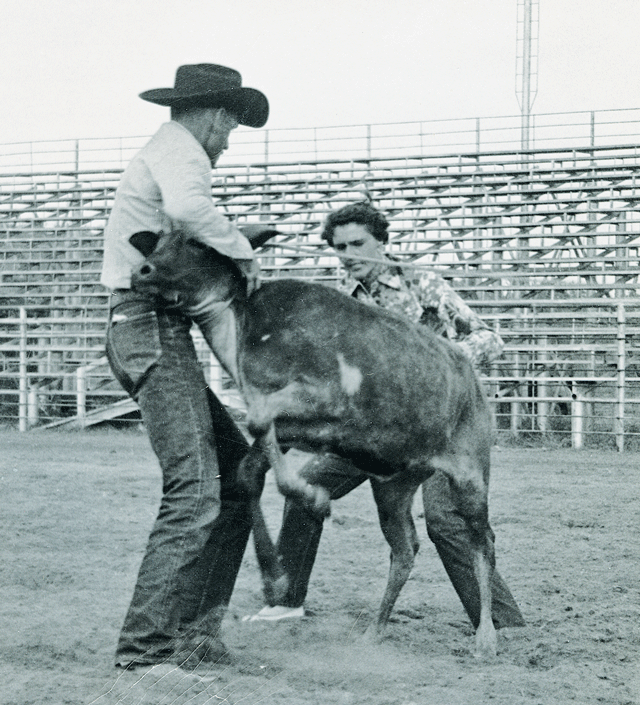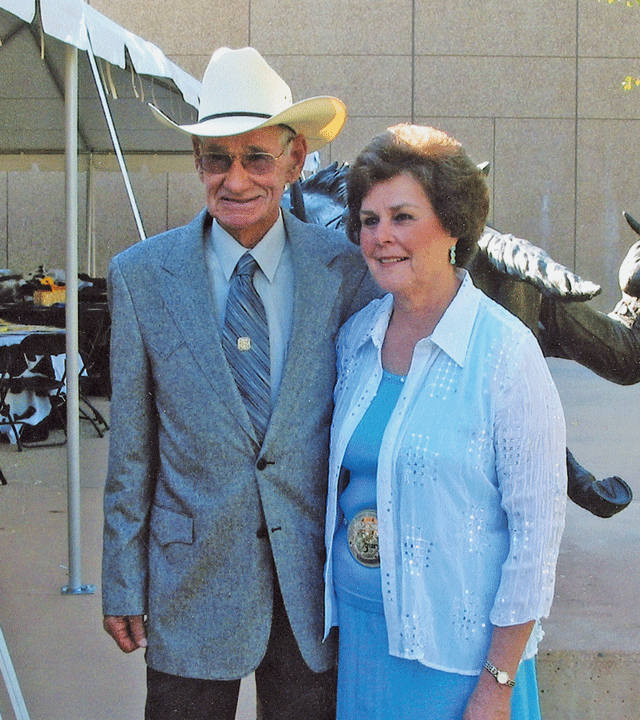From the time he was a baby, all John Farris ever wanted to do was be a cowboy. And he spent his life doing it. The Addington, Oklahoma man was born in 1928 in Iowa Park, Texas, the son of B.A. and Eva Farris. When the neighbor’s cows got out and onto Farris property, John and his brother would ride them. At the age of sixteen, he hitchhiked to the rodeo in Jacksboro, Texas, to ride a bull. He got hit in the mouth, and when his parents found out where he’d been, “they threw a fit,” John remembers.
But it didn’t discourage him. He graduated high school in 1944 and went to work, plowing for neighbors and working in the oilfield. He rodeoed, too, riding bareback horses, saddle bronc horses, bulls, roping, and even doing a little steer wrestling. Of his events, he won the most money at the saddle bronc riding and bull riding. In 1951, he won the wild horse race and placed in the amateur bronc riding at Cheyenne Frontier Days.
It was at a rodeo in Stanford, Texas, in 1954 when he met a striking dark-haired barrel racer. John and Mildred Cotten met on July 4 and were married the next year. She was an accomplished barrel racer, winning the Texas Barrel Racers Association championship in 1955-57. When she joined the Girls Rodeo Association (the predecessor to the Women’s Pro Rodeo Association) in 1958, she began going to pro rodeos, and in 1957, John got his RCA (Rodeo Cowboys Association, the forerunner to the Pro Rodeo Cowboys Association) card, and the two traveled together.
They spent the next fifty-plus years together, rodeoing and traveling across the nation.



In 1962, they began working for stock contractor Tommy Steiner. Mildred took entries (those were the days before Procom and the computerized entry system, when contestants called the rodeo secretary to enter) and secretaried the rodeo. John was chute boss, for either the timed event end or the roughstock end, or both. Steiner was the first producer they worked for, but throughout their lives, they worked for others: Harper Morgan Rodeo Co., Neal Gay, Don Gay, Stace Smith, Mack Altizer, the Auger Rodeo Co., Mike Cervi, and more.
When the Farris’s worked a rodeo, things went smoothly; the pay-out was right, the arena was clean, and the stock was loaded correctly.
While they worked for stock contractors, both continued to compete. John rode bulls till the age of 44, and Mildred qualified for the National Finals Rodeo thirteen times.
In 1967, one of the years Mildred made the NFR, John began a career of working the NFR that would last till 2012. Throughout those forty-six years, John did everything from security work to caring for grand entry saddle horses to working as chute boss. He was timed event chute boss for years, sorting cattle, setting the barrier, and making sure the animals were in the right sequence. He’s best known by rodeo fans as they saw him on TV: flagging in the next barrel racer during each night of the NFR. He set the barrel pattern at the NFR every year, from 1967 to 2012.
The couple rodeoed nearly year-round. They would be gone all summer and most of the fall. After the NFR, they would be home till the Texas Circuit Finals on New Year’s, then home again until Ft. Worth started. The couple moved to Addington, to be near John’s parents. Their sons: Billy Tom and Johnny, stayed with B.A. and Eva Farris during the school year. As soon as school got out, the boys were with them. And during the school year, if the rodeo was close, John might run up to Addington to pick them up for a weekend, or a contestant traveling south might bring them. A few times, Tommy Steiner flew his airplane to get them.
They worked thirty-five or forty rodeos a year, and as soon as their boys were old enough, they were on the labor list. They pushed calves and took saddles off, among other chores. “We’d rather do that than run around,” Johnny remembered.
John and Mildred would call and check in on their kids but if the boys needed to get ahold of their parents, they called Procom. It was before the invention of the cell phone, and Procom would give the boys the number for the rodeo their parents were at. Then the boys would wait till entries opened for the rodeo, and Mildred would answer their call.



John was working for Tommy Steiner when Tommy was the first producer to use the electric eye for the barrel race. He was with Tommy when it was purchased. He also considers improvements to the judging system as another forward step in pro rodeo. Before the professional judging system, a cowboy might get scored poorly if he wasn’t a friend of the judge. When the pro system started, it leveled the playing field.
John and Mildred were reserved, but they took care of business, said Vickie Shireman, a PRCA secretary who knows the Farris family and worked with the couple. “They were very well respected. They were quiet, but if somebody needed help, John and Mildred would be the first to help.” They helped numerous cowboys and cowgirls get started, nurturing young people on the rodeo road. Buddy Lytle, a tie-down roper, steer wrestler, and later, a judge, lived with the family for years. Announcer Mike Mathis was a friend of the family. “John was an amazing cowboy,” he said. “He was a hell of a competitor, and he and Mildred were a team.” Rodeo producers knew that when John and Mildred worked for them, things would go smoothly. “No matter where,” Mike said, the work “was going to be taken care of, and properly.”
One of John’s favorite parts of rodeo was the people. As contract labor, he and Mildred would be in town for the entire week of rodeo, and made countless friends among contestants, contract personnel, and committee members. They watched children of friends grow up, often seeing multiple generations compete. John worked through hundreds of hours of slack, sometimes six or seven hours a day, but it never got old for him. Once, after three days of slack at a rodeo, world champion tie-down roper Fred Whitfield asked John if he was tired of it. No, he answered, “because I get to see everybody.”
Mildred passed away in 2013; before she died, she and John were recognized numerous times. They are the only couple to be inducted into the Pro Rodeo Hall of Fame (2006); the Texas Rodeo Cowboy Hall of Fame (2004) and the Rodeo Hall of Fame in the National Cowboy and Western Heritage Museum in Oklahoma City (2010).
John was chute boss for the Texas Circuit Finals for twenty years and received the WPRA’s Outstanding Individual Award in 1999. He was Texas Circuit Man of the Year in 1997. Mildred was PRCA Secretary of the Year eight times and served as a director, vice-president and president of the Girls Rodeo Association and Women’s Pro Rodeo Association.
His family: Bill and wife Sally, and Johnny and wife Jan, threw a ninetieth birthday party for him last year. More than 140 people came to visit with John and celebrate his life. John has four grandchildren and two great-grandchildren.









